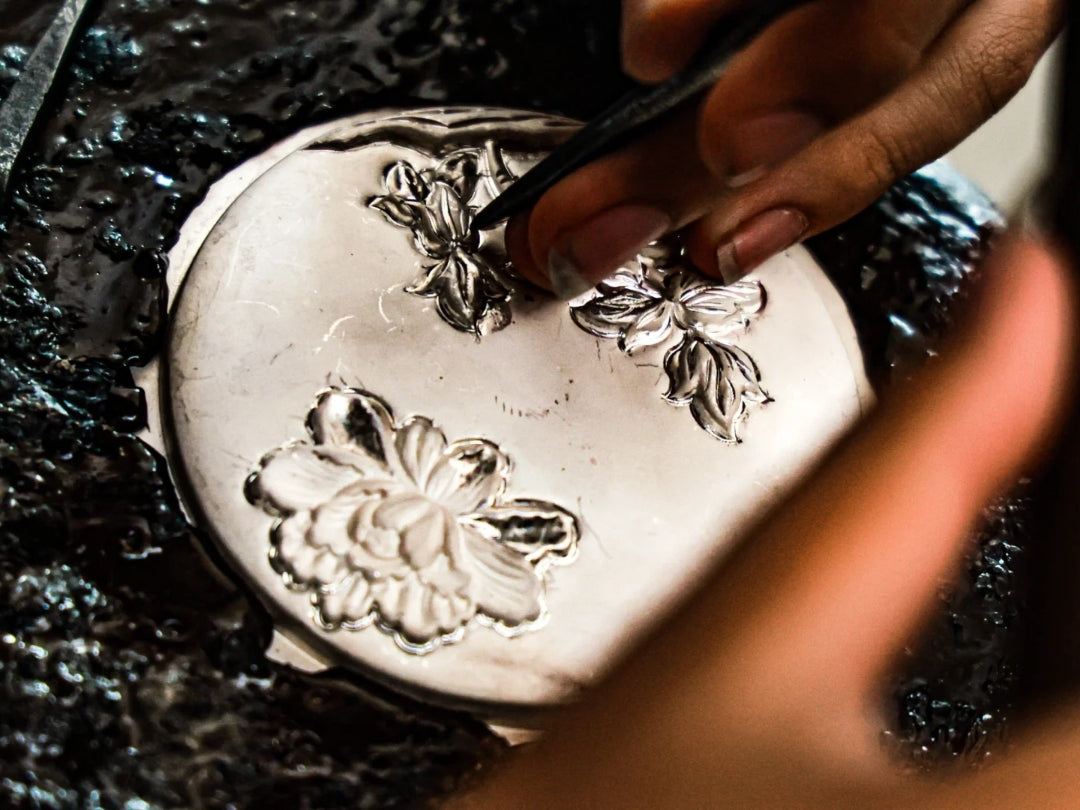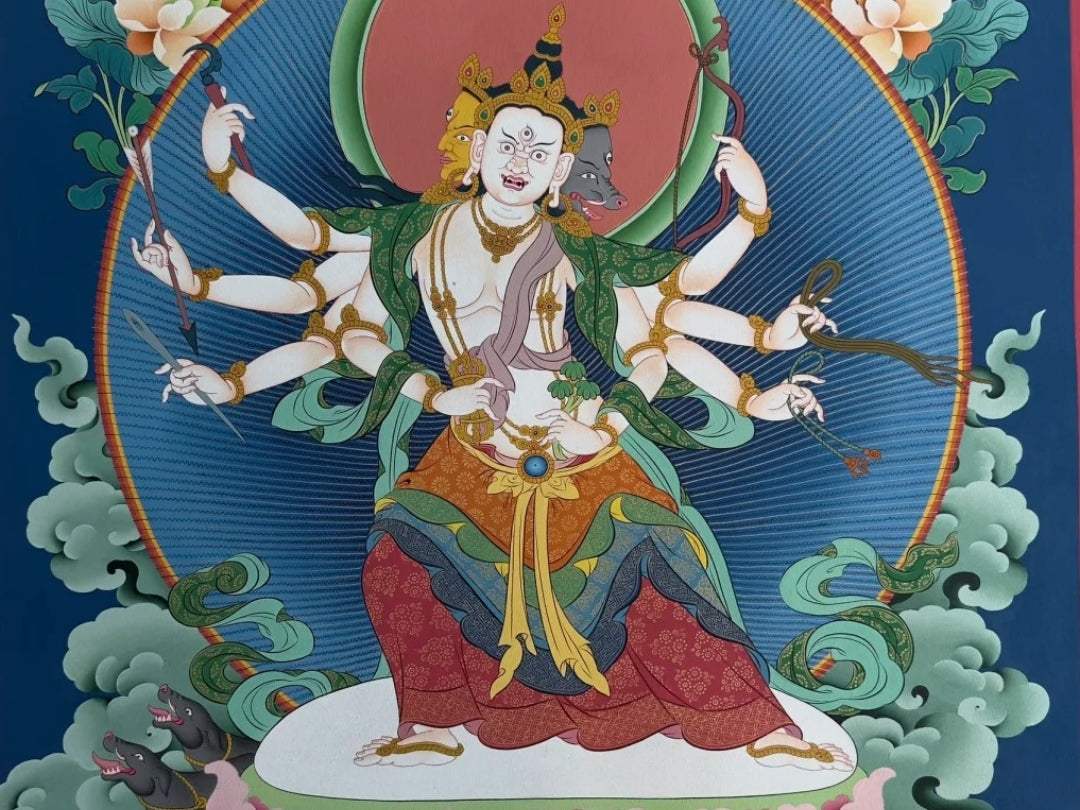In the mid-1800s, daring British explorers and missionaries returned from the Himalayas carrying more than just tales of snow-capped peaks—they brought back Tibetan Ga Wu Boxes, small “little shrine” amulets that encapsulated centuries of Himalayan faith in a wearable form. Across the same era, Victorian England mourned and commemorated loved ones with lockets tucked close to the heart. This unexpected meeting of Tibetan and European traditions sparked a fascinating evolution in personal adornment. In this article, we trace how Ga Wu Boxes inspired the refinement of Victorian lockets, and how each form—one openly devotional, the other secretly sentimental—reflects its culture’s approach to protection, memory, and the sacred.

1. The Original Ga Wu Box: A Portable Tibetan Shrine
What Is a Ga Wu Box?
-
In Tibetan Buddhism, a Ga Wu Box (གག་བུ་དོན་)—literally “little box”—serves as a tiny shrine or protective amulet worn close to the body.
-
Traditionally made from brass, silver, or copper, it houses miniature Thangka paintings, tiny sacred scrolls, mantras sealed on hand-rolled paper, fragments of relics, or blessed herbs.
-
Because its lid opens, wearers can slip in fresh prayer offerings or rotate scrolls, maintaining an ongoing connection to their personal practice.
Symbolic Significance:
-
Worn over the heart, a Ga Wu Box acts as a constant reminder of collective Tibetan Buddhist faith—inviting protection, purification of negative karma, and blessings from deities like Amitabha, Manjushri, or Green Tara.
-
Its open design signifies transparency and communal devotion; devotees do not hide their faith but carry it outwardly in plain sight.
Spread to the West:
-
By the 1870s, British officers and Indian army surveyors stationed in India brought Ga Wu Boxes back to London.
-
The novelty of a “little shrine” that opened and closed piqued Victorian interest; some early travelers even commissioned small lockets modeled on Ga Wu structure.
2. The Victorian Locket: A Private Capsule of Memory
What Is a Victorian Locket?
-
In Victorian England, wearing a locked, hinged pendant became popular following Prince Albert’s death in 1861.
-
Lockets typically contained miniature portraits, hair locks, pressed flowers, or woven fabric—tangible mementos of a lost spouse, child, or close friend.
Symbolic Significance:
-
A Victorian locket’s concealed interior spoke to the era’s emphasis on personal grief and romantic memory.
-
The fact that lockets remained closed except when opened by the wearer underscored the intimate, often hidden nature of Victorian sentimentality.
Opportunities for Cross-Pollination:
-
Jewelers in London began crafting “Himalayan-inspired lockets” featuring small sliding doors, paying homage to the Ga Wu’s open/close mechanism.
-
Some wealthy collectors imported actual Ga Wu Boxes, repurposed them with engraved initials, or lined them with crimson velvet—melding Himalayan devotion with British nostalgia.
3. Open vs. Closed: Contrasting Structures and Meanings
| Feature | Tibetan Ga Wu Box | Victorian Locket |
|---|---|---|
| Purpose | Collective spiritual practice; protection through visible devotion | Private remembrance; sentiment preserved behind a hidden panel |
| Structure | Hinged, open-faced design; often displays miniature Thangka or mantras | Hinged, fully enclosed—interior hidden until manually opened |
| Symbolism | Public declaration of faith; blessings flow outward | Personal grief or love; memories kept close but concealed from view |
| Materials | Brass, silver, copper, sometimes inlaid with turquoise or coral | Gold, silver, enamel, sometimes set with gemstones or intertwined hair |
| Usage | Refillable with fresh prayers, mantras, or relics |
Filled once (portraits, hair, notes) and typically left untouched |
4. Hybrid Inspirations: From Open Shrine to Secret Keepsake
4.1. Early Victorian “Ga Wu–Style” Lockets
-
Jewelers in the 1880s began marketing “Himalayan Keepsake Lockets” with sliding doors and small compartments reminiscent of Ga Wu Boxes.
-
Inside, instead of mantras, these hybrid lockets held family crests, miniature daguerreotypes, and even scraps of exotic papers from India—bridging Eastern mysticism with Western elegance.
4.2. Modern Revival: QiLing Aura’s Ga Wu–Locket-Inspired Pendants
-
QiLing Aura offers a collection of Hand-Painted Thangka Ga Wu Box Pendants that combine classic Tibetan techniques with refined locket sensibility.
-
Each pendant opens to reveal a hand-painted miniature of Medicine Buddha, Avalokiteshvara, or Manjushri, surrounded by a red-sand brass finish.
-
Wearers can place fresh mantras or tiny relics inside, while the exterior is subtly embellished with filigree patterns evoking Victorian lockets.
-
-
By marrying Tibetan Thangka art with a discrete closing mechanism, these modern Ga Wu–lockets pay respect to both traditions—allowing spiritual seekers to carry visible devotion and private intention in a single piece.
5. Cross-Cultural Takeaways
5.1. Visible Faith vs. Hidden Memory
-
Across Tibet, the Ga Wu Box’s open design remaps jewelry into a living shrine—inviting blessings into one’s daily life.
-
In Victorian England, lockets internalized remembrance, making grief and love private and sacred.
-
Today’s hybrid forms encourage us to balance public intention with personal reflection—announcing faith in subtle ways while preserving intimate meaning within.
5.2. Enduring Appeal of Compartments
-
Whether used to store mantras or cherished mementos, small compartments in jewelry tap into a universal desire: to protect what matters most.
-
This convergence of Tibetan spirituality and Victorian sentiment reminds us that humans across cultures seek tangible anchors—objects that carry energy, memory, and hope.
6. Incorporating Ga Wu–Locket Pendants into Daily Life
-
Ritual Filling:
-
Begin each month by placing fresh handwritten mantras or small blessings inside your Ga Wu–locket. Let the act renew your intention.
-
Alternatively, slip in a dried rose petal, a pressed leaf, or a loved one’s lock of hair to honor personal memory.
-
-
Mindful Opening:
-
Whenever you feel overwhelmed, open the locket for a moment of contemplation—view the Thangka image or private keepsake and recite a short prayer.
-
This simple action can ground you, much as Victorian lockets offered comfort to those in mourning.
-
-
Styling Tips:
-
Pair a Ga Wu–style pendant with layers of beaded necklaces for a boho-spiritual look that nods to its Himalayan roots.
-
For an effortless everyday style, wear it alone on a slender black agate chain to let its intricate details shine.
-
-
Gift of Dual Meaning:
-
A Ga Wu–locket makes a thoughtful present for weddings, birthdays, or spiritual milestones—honoring faith and personal story simultaneously.
-
Consider including a small handwritten mantra or keepsake in the box interior before gifting, embedding your love or blessing directly into the piece.
-
Conclusion
The unlikely meeting of Tibetan Ga Wu Boxes and Victorian lockets in the 19th century sparked a cross-cultural exchange that resonates today. Where one tradition wore its faith openly—displaying tiny painted Buddhas and prayer rolls—the other cherished private memory behind closed panels. Modern artisans at QiLing Aura celebrate both legacies by creating miniature Ga Wu–lockets: sacred pendants that balance collective devotion with intimate keepsake.
Whether you’re drawn to the protective power of a Ga Wu shrine or the tender memory of a locket’s secret compartment, these hybrid designs remind us that jewelry can be more than ornamentation—it can be a vessel for faith, love, and remembrance that transcends culture and time.
Embrace this cross-cultural love story and carry both public devotion and private memory wherever you go.





